Trees and Shrubs at Johnson Entrance
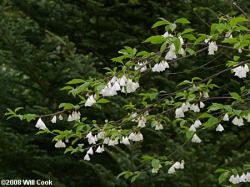
MOUNTAIN SILVERBELL
Halesia tetraptera or Helisia carolina
There are two of these trees planted just outside the main doors of the library in Natick.
CULTURE: likes shade, leaves become yellow throughout the summer in high acidic soil. Yellow leaves in fall.
WILDLIFE: Squirrels eat seeds and flowers are attractive to bees.
Trees and Shrubs in the Native Garden
Identification of trees and shrubs in native garden
Starting at Pitt Street and going up the garden... Sweet Pepperbush is in the rear first section by the Joe Pye Weed. Ninebark (cultivar Coppertina and the true species)is at the rear of the next section. Past the mature tree there are 2 Witch Hazel, then 1 Spicebush, then 2 Mountain Silverbell, then 2 Umbrella Magnolia, then 3 Pussy Willow, all 10 plant were planted as bareroots in 2009. In the front of the middle section is 4 American Cranberry bush and 3 Blueberry cultivars. At the top of the garden is 1 RedCedar.
Starting at Pitt Street and going up the garden... Sweet Pepperbush is in the rear first section by the Joe Pye Weed. Ninebark (cultivar Coppertina and the true species)is at the rear of the next section. Past the mature tree there are 2 Witch Hazel, then 1 Spicebush, then 2 Mountain Silverbell, then 2 Umbrella Magnolia, then 3 Pussy Willow, all 10 plant were planted as bareroots in 2009. In the front of the middle section is 4 American Cranberry bush and 3 Blueberry cultivars. At the top of the garden is 1 RedCedar.
Umbrella Magnolia
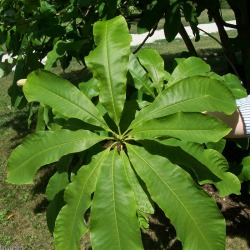
Umbrella Magnolia (Magnolia tripetala)
CULTURE: an understory tree that grows along cool, moist mountain streams and next to swampland. In the wild, it usually grows about 30 feet tall and wide. The main trunk sends up a number of fast growing suckers from near the base.
DISTRIBUTION: ranges down the spine of Appalachia and across the woodlands of the mid-South to as far west as eastern Oklahoma.
WILDLIFE: Large leaves and flowers are evidence of a primitive tree. Magnolias are one of the oldest surviving tree species. It is pollinated by beetles who are not as delicate as bees and butterflies and pollinate more like a bull in a china shop. (Magnolias evolved 25 million years before the occurrence of bees).
CULTURE: an understory tree that grows along cool, moist mountain streams and next to swampland. In the wild, it usually grows about 30 feet tall and wide. The main trunk sends up a number of fast growing suckers from near the base.
DISTRIBUTION: ranges down the spine of Appalachia and across the woodlands of the mid-South to as far west as eastern Oklahoma.
WILDLIFE: Large leaves and flowers are evidence of a primitive tree. Magnolias are one of the oldest surviving tree species. It is pollinated by beetles who are not as delicate as bees and butterflies and pollinate more like a bull in a china shop. (Magnolias evolved 25 million years before the occurrence of bees).
Sweet Pepperbush or Clethra Alnifolia
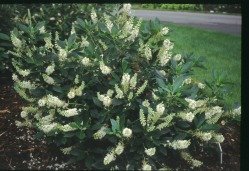
Sweet pepperbush or Clethra alnifolia
CULTURE: A little gangly in the spring, but beautiful fragrant blooms in late summer. In wild found by water, and being replaced by invasive glossy buckthorn.
WILDLIFE: Flowers attract butterflies (Viceroy, Morning Cloak) and bees.
DISTRIBUTION: Coastal states of Eastern US
CULTURE: A little gangly in the spring, but beautiful fragrant blooms in late summer. In wild found by water, and being replaced by invasive glossy buckthorn.
WILDLIFE: Flowers attract butterflies (Viceroy, Morning Cloak) and bees.
DISTRIBUTION: Coastal states of Eastern US
Witch Hazel
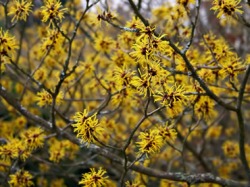
Witch Hazel or Hamamelia
CULTURE: Rarely bothered by pests or diseases.
WILDLIFE: Seeds for birds, rabbits and deer.
DISTRIBUTION: found in all states east of the Mississippi, and Oklahoma and Texas.
MEDICINAL/HUMAN USES: Used for centuries to treat skin ailments. Used for dousing or divining for water, a forked branch of witch hazel was used to locate underground water sources. True Hazel which grows in Europe was used for this initially, but settlers in the US used Witch Hazel which looks similiar.
CULTURE: Rarely bothered by pests or diseases.
WILDLIFE: Seeds for birds, rabbits and deer.
DISTRIBUTION: found in all states east of the Mississippi, and Oklahoma and Texas.
MEDICINAL/HUMAN USES: Used for centuries to treat skin ailments. Used for dousing or divining for water, a forked branch of witch hazel was used to locate underground water sources. True Hazel which grows in Europe was used for this initially, but settlers in the US used Witch Hazel which looks similiar.
Ninebark
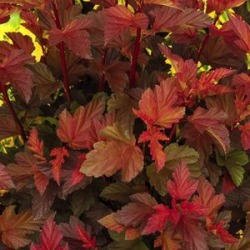
Ninebark or Physocarpus
Culture: easy and adaptable in shade-sun. Benefits from yearly pruning, easy to transplant. Peeling bark on older stems, said to have nine layers of bark.
WILDLIFE: Flowers in June for bees and berries in the fall for birds.
DISTRIBUTION: Quebec to Tennessee
Culture: easy and adaptable in shade-sun. Benefits from yearly pruning, easy to transplant. Peeling bark on older stems, said to have nine layers of bark.
WILDLIFE: Flowers in June for bees and berries in the fall for birds.
DISTRIBUTION: Quebec to Tennessee
American Cranberry Bush
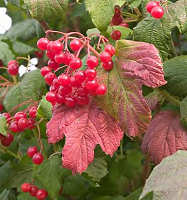
American Cranberry Bush (Viburnum trilobum), a/k/a Crampbark Tree, Dog Rowan Tree
CULTURE: Very few insect problems. Zone 2 -7. Insects such as aphids, scale insects, weevils, Japanese beetles, mealybugs, and treehoppers are common, while Botrytis, rust, mildews, wood rot, Verticillium wilt, leaf spots, and dieback also occur. Other sources say it has no serious pests.
DISTRIBUTION: WILDLIFE: Excellent berries for birds, flowers attractive to birds and butterflies.
CULTURE: Very few insect problems. Zone 2 -7. Insects such as aphids, scale insects, weevils, Japanese beetles, mealybugs, and treehoppers are common, while Botrytis, rust, mildews, wood rot, Verticillium wilt, leaf spots, and dieback also occur. Other sources say it has no serious pests.
DISTRIBUTION: WILDLIFE: Excellent berries for birds, flowers attractive to birds and butterflies.
Elderberry
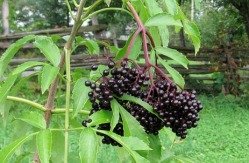
Elderberry
Sambucus nigra
CULTURE: Prune heavily in winter to maintain thick form. Elderberry is a fast grower and aggressive competitor with weeds and herbaceous species. Individual plants are very short-lived, however root masses produce new shoots. Cutting the whole bush to the groud every other year may be necessary to keep the bushes in check. This forest species will grow in full sun if the soil is well-tilled and watered. It can be planted as a hedge or alone. Provides effective erosion control on moist sites.
WILDLIFE: This plant was used by Native Americans for many medicinal purposes.
The purple-black fruit is attractive to birds that spread the seeds. The fruit makes tasty jelly and wine. The fruit should not be eaten until it is cooked to break down toxins.
DISTRIBUTION: Nova Scotia to Florida
Pussy Willow
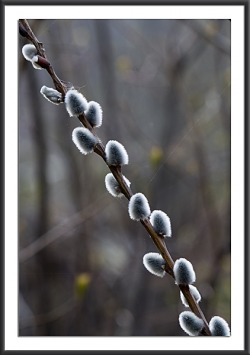
Pussy willow or Salix discolor
CULTURE: Likes wet and sunny locations. Short-lived, but sends out suckers. Good for erosion control.
WILDLIFE: Early nectar source, leaves are. Finches, grouse and cardinals eat flower buds. Host plant for Viceroys and Red Spotted Purples.
DISTRIBUTION: Northern half of US and most of Canada.
Coppertina
CULTURE: Likes wet and sunny locations. Short-lived, but sends out suckers. Good for erosion control.
WILDLIFE: Early nectar source, leaves are. Finches, grouse and cardinals eat flower buds. Host plant for Viceroys and Red Spotted Purples.
DISTRIBUTION: Northern half of US and most of Canada.
Coppertina
Red Cedar
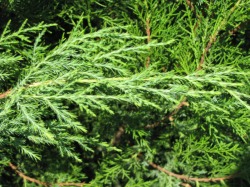
Red Cedar or juniperus virginiana
CULTURE: Early succession tree requires sun. A host for Applle-Cedar Rust which affects Apple and Sarviceberry trees.
WILDLIFE: One of the top ten trees for wildlife. Provides nutritious berries throughout the winter and evergreen needles for shelter. Berries especially loved by Bluebirds and Cedar Waxwings. Deer browse tips.
DISTRIBUTION: Eastern 2/3 of US
CULTURE: Early succession tree requires sun. A host for Applle-Cedar Rust which affects Apple and Sarviceberry trees.
WILDLIFE: One of the top ten trees for wildlife. Provides nutritious berries throughout the winter and evergreen needles for shelter. Berries especially loved by Bluebirds and Cedar Waxwings. Deer browse tips.
DISTRIBUTION: Eastern 2/3 of US
